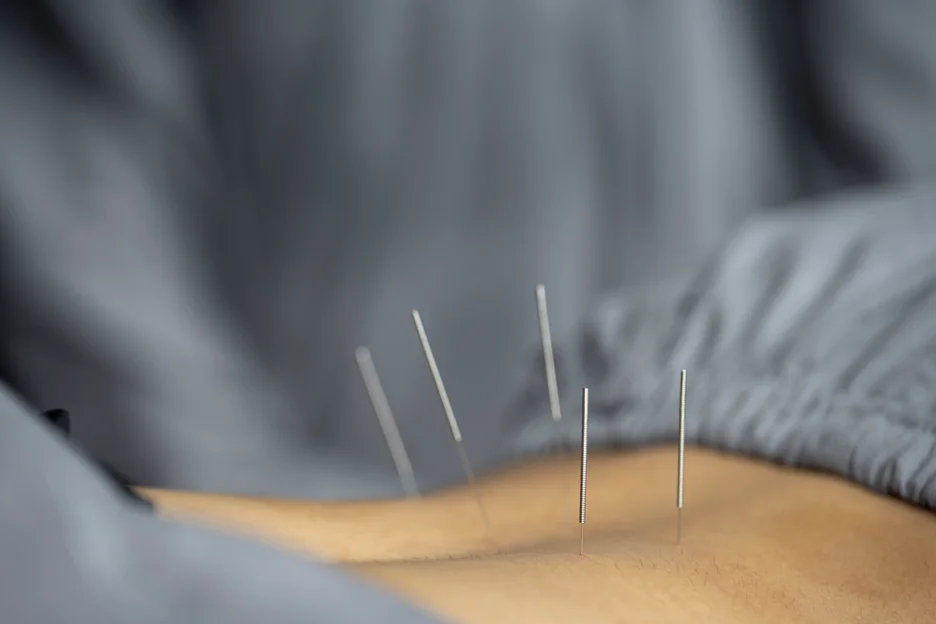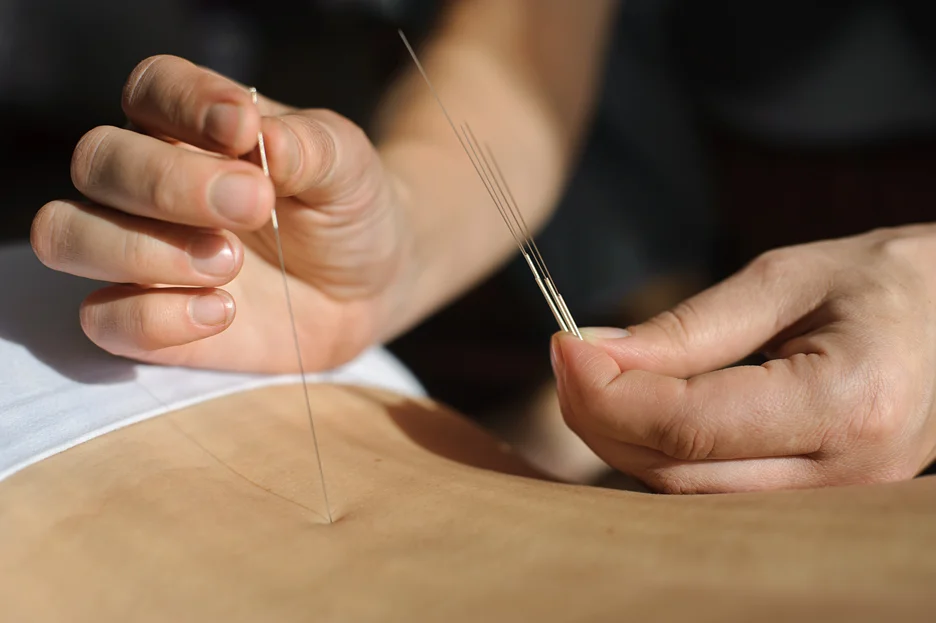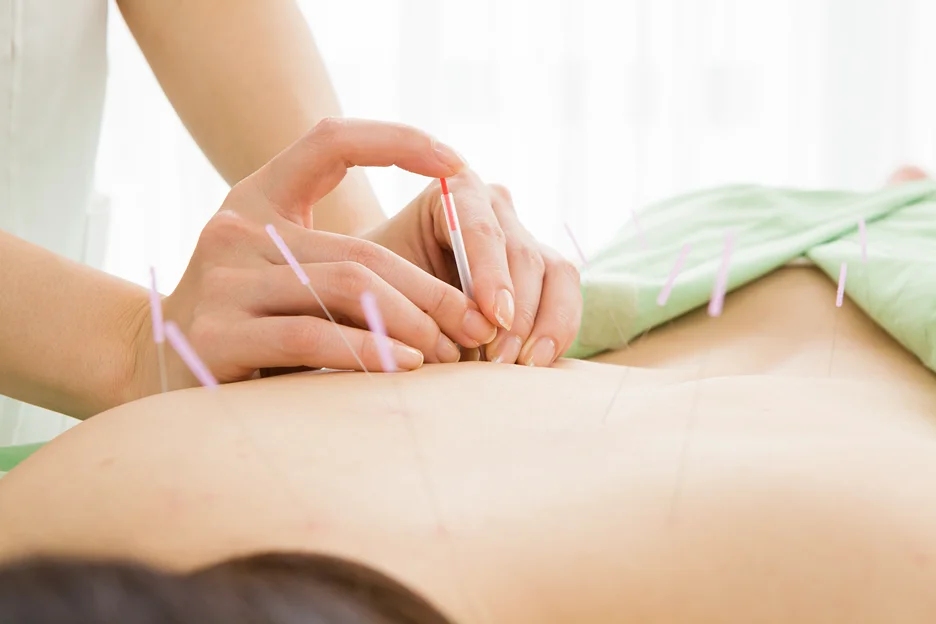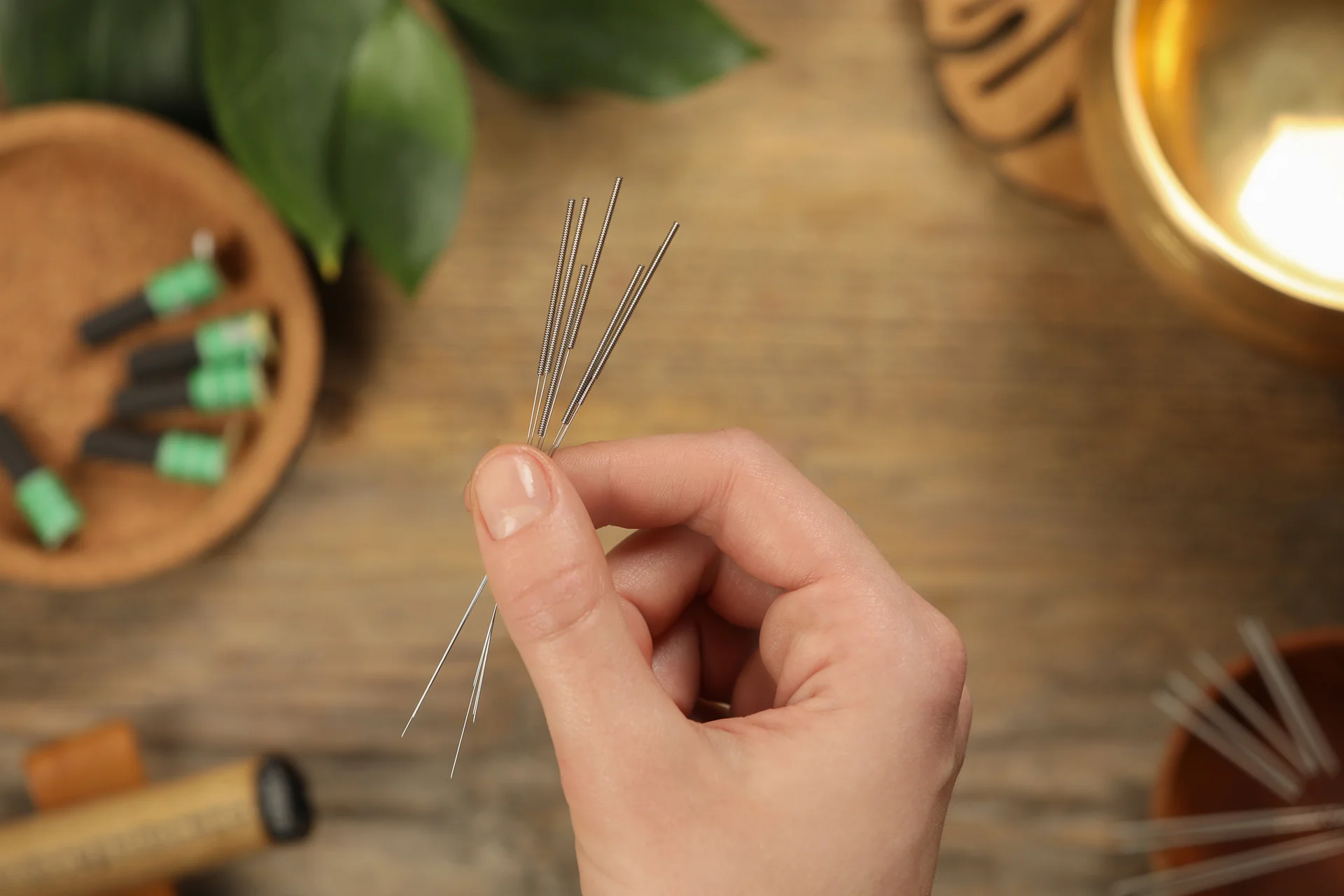Does your back pain have you out of whack? Acupuncture could very well get you back on track.
Due to the varying degrees of back pain worldwide, there will come a point when a person who suffers from back pain will ask, “Why not try acupuncture?”
Clinical studies show inserting thin needles into strategic energy points can offer mild to moderate back pain improvement for many sufferers.
But how exactly does it work and will Medicare foot the bill? What about at-home options like acupressure mats? We’ll address those burning questions and more in this beginner’s guide to getting to the point of back pain relief through acupuncture.
Back discomfort got you in a bind? Kaly can match you to skilled specialists in your city.
Is Acupuncture Good for Back Pain Relief?

Yes, acupuncture is good for relieving many types of acute and chronic back pain, providing mild to moderate improvement versus no treatment based on clinical trial analysis.
Based on clinical studies analyzed by our team, there is moderate evidence that acupuncture provides mild to moderate short-term improvements in both pain levels and physical function for chronic lower back pain sufferers compared to receiving no treatment.
Multiple reviews do show acupuncture reduces pain over sham acupuncture as well. However, much of the research is hampered by limitations like small sample sizes, inadequate follow-up, and design flaws that may skew outcomes.
There is still debate around whether the benefits are greater than placebo effects. More rigorous, large-scale studies with longer tracking are required to truly gauge acupuncture’s efficacy and longevity for back pain relief.
Do you wonder exactly how acupuncture relieves back discomfort? Kaly experts advise that proposed mechanisms include:
- Stimulating acupoints releases natural pain-relieving chemicals like endorphins in your nervous system.
- Acupuncture may decrease inflammation in your back by regulating inflammatory markers.
- Electroacupuncture techniques can change the way your brain processes painful signals.
When should you consider acupuncture for back pain relief? The Kaly specialists recommend acupuncture as part of a comprehensive plan with conventional therapies based on clinical evidence.
While not a cure-all, it is one promising option to try under professional supervision to optimize outcomes.
Have you tried other back pain remedies without success? Our experts encourage acupuncture, as current data shows it can provide mild to moderate improvements in function and comfort over the short-term for many chronic back pain sufferers.
What are the Acupuncture Points for Back Pain?
Key acupuncture points for back pain include BL23, BL25, BL40, GV3, GB30, GB34, Huatojiaji, and Ashi points along the spine, sacrum, legs and abdomen according to specialist experience.
Proper point selection is always customized to each patient’s specific needs. However, our acupuncturists recommend focusing on these key targets for the best outcomes:
Acupuncture Points for Lower Back Pain
Lower back discomfort is one of the most common types of pain treated with acupuncture. Kaly practitioners suggest several powerful acupoints to alleviate lumbar and sacral pain:
- BL23 and BL25 – These paired points are situated right beside the spine at waist level. Stimulating them helps improve spinal energy circulation to reduce low back achiness and stiffness.
- BL40 – Located midway between the kneecap and inner ankle, this leg point also strongly impacts the lumbar region in acupuncture theory.
- GV3 – Found between the spine’s base and tailbone, this spot balances pelvic alignment and sciatic nerve irritation.
Acupuncture Points for Middle and Upper Back Pain
For discomfort higher up in the thoracic spine region, different acupoints come into play:
- Du Meridian – Needling various points along the Du meridian running up the center of the spine can relieve muscle tension. Targets include Du3 in the low back up through Du4 in the mid-back.
- Huatojiaji – These lateral spine points between vertebrae improve energy circulation to the back-benefiting organs.
- Ashi Points – Ashi points treat localized pain right where you feel it most. They are tender on palpation.
Acupuncture Points for Radiating Back Pain
Back issues often cause referred pain into the hips, legs and buttocks. For radiating symptoms, Kaly acupuncturists suggest:
- GB30 – This buttock point calms sciatic and hip pain that accompanies sacral problems.
- BL36, BL37 – Below the knees, these leg points address hamstring tightness from back tension.
- CV6 – Found under the navel, needling this abdominal point balances core muscles.
Does Acupuncture Hurt in the Back Area?
No, most patients do not find acupuncture painful based on our observations. Acupuncture involves inserting thin needles into strategic points on the body. So it’s natural to be concerned about possible pain, especially when treating sensitive areas like the back.
Here’s what to expect pain-wise according to Kaly patients and specialists:
Minimal Discomfort During Needle Insertion
Once the needles are properly placed, there should not be any residual sharp pains. You may notice a dull ache around the insertion sites, but this is normal and fades quickly. With proper technique, the needle insertion process is far less painful than most people anticipate.
Managing Discomfort in Thicker Muscles
Some points in dense tissues like the back and legs can cause momentary aching when penetrated according to Kaly experts. But even this dissipates rapidly once the needles are in position. Your body’s natural pain-relieving chemicals kick in rapidly to minimize any sensations.
What to Do If You Feel Significant Pain
Inform your acupuncturist right away if you feel unexpected sharp pain during needle insertion or placement. An experienced practitioner will quickly adjust or remove any problem needles causing discomfort. Most patients tolerate acupuncture extremely well when done correctly.
Does Acupuncture Have Any Side Effects?
The most common side effects our experts see are:
- Soreness, bruising or minor bleeding where needles are inserted
- Fatigue during or after treatment sessions
- Lightheadedness right after acupuncture
- Nausea in sensitive patients
Kaly acupuncturists emphasize these effects are manageable and resolve fully within a day or two. Let your practitioner know if any side effects concern you. Staying hydrated and resting after treatments can help minimize them.
- Less commonly, patients may experience:
- Muscle twitching or temporary spasms
- Tingling sensations around needle sites
- Exhaustion following treatment
Again, the specialists in our network advise these types of reactions are temporary and not harmful. Your body is just responding to the therapeutic needling.
Very rarely, more serious issues like infections or injured organs can occur if procedures are not followed properly. However, Kaly acupuncturists are specially trained to handle needles safely and avoid these risks.
How Long Does Acupuncture Last for Back Pain Relief?

For acute back pain, patients report a few hours to 3 days of relief after each acupuncture treatment before pain returns based on studies. More frequent sessions lead to longer cumulative benefits.
For chronic back pain, acupuncture relief lasts about 12-36 hours after each session, requiring multiple treatments over weeks for cumulative lasting benefits per studies.
In chronic back pain patients, research shows acupuncture effectively produces 12-36 hours of pain relief and improved function after each visit compared to no or sham treatment.
Studies suggest long-term relief of chronic back pain requires an initial course of 8-12 acupuncture sessions over 4-6 weeks, with 1-2 visits per week.
Patients typically notice some improvements after the first 1-3 treatments, but the full therapeutic effects take 2-4 weeks to build with consistent acupuncture.
Monthly maintenance sessions after the initial course can help sustain chronic back pain relief according to studies. For recurring pain, acupuncture may need to be integrated as an ongoing approach.
Does Medicare Cover Acupuncture for Back Pain?
Yes, Medicare covers acupuncture for back pain. Medicare covers up to 20 acupuncture sessions per year for chronic lower back pain alone if specific criteria are met according to Medicare regulations.
The requirements set by Medicare for acupuncture reimbursement are:
- The back pain must be classified as chronic, lasting 12 weeks or more with no clear cause.
- The pain cannot be related to surgery, pregnancy or other systemic disorders.
- Only chronic lower back pain is covered, not mid or upper back conditions.
- Treatments must be performed by licensed acupuncture practitioners or other Medicare providers.
- Up to 12 initial acupuncture sessions may be covered. If pain improves, up to 8 more sessions may be approved.
- In total, Medicare will cover a maximum of 20 acupuncture visits per year for chronic low back pain.
- After paying the Part B deductible, you pay 20% coinsurance per covered session.
- Each appointment cannot exceed 45 minutes for reimbursement.
Can Acupuncture in the Ear Help with Back Pain?
Yes, acupuncture in the ear helps with back pain. Clinical trial evidence suggests auricular acupuncture effectively reduces chronic lower back pain versus sham or standard care based on analysis by specialists.
Ear acupuncture, also called auricular therapy, is a unique microsystem approach that treats the whole body by needling specific points on the outer ear.
Evidence That Ear Acupuncture Reduces Back Pain
Multiple clinical trials find auricular acupuncture significantly decreases pain and disability in chronic lower back pain patients versus sham or standard care.
One study found a 4-week course reduced pain intensity by 56% and improved physical function by 26%.
Proposed mechanisms activate natural pain-relieving chemicals and pathways in the central nervous system.
Ear Acupressure Research Findings
- Studies show patients self-pressing with beads on key ear points throughout the day (auricular acupressure) also reduces chronic low back pain.
- This allows people to administer their own ear point therapy for convenience.
Commonly Used Auricular Points for Back Pain Relief
- Shenmen, kidney, and lumbar spine points directly treat low back discomfort.
- Additional points may be selected based on your Traditional Chinese Medicine diagnosis.
An auricular acupuncture specialist will customize the best ear points for your condition.
Can an Acupuncture Mat Help with Back Pain?
Limited studies suggest acupuncture mats may temporarily relieve back pain by stimulating acupressure points, but more research is still needed on long-term efficacy.
- The plastic mat spikes apply pressure to acupoints, which stimulates nerves and increases blood flow based on acupuncture theory.
- This is believed to release muscle tension, promote circulation, and activate natural pain-relieving endorphins in the body.
- Users may feel mild discomfort initially as the points are stimulated, but this dissipates quickly.
What Does Research Indicate About Acupuncture Mat Benefits?
One study found using a mat reduced pain and improved function in chronic lower back pain patients doing exercise versus exercise alone.
Another study showed acupressure mats increased pain tolerance and decreased perceived pain in back and neck pain sufferers.
More research is needed, but results are promising and user feedback is generally positive.
How Do I Use an Acupuncture Pen for Back Pain?
Experts suggest using acupuncture pens daily on low back points like BL23, BL25 with heat first, starting at low intensity, and increasing as tolerated for at-home back pain relief.
- Start with lower intensity settings around levels 1-3, holding the pen perpendicular to the skin. Slowly increase intensity as your body acclimates.
- Focus on key acupoints like BL23, BL25 and BL40 along the spine, and GB30 for the buttocks. Glide the tip over each point for 20-30 seconds.
- Don’t forget distal points farther from the back like LI4 and LV3. Stimulating these can also provide benefits.
- For best results, take 5-10 minutes daily to apply the acupuncture pen to sore spots and points. Consistency is key.
- First use a heat pack on the back for 10-15 minutes to relax the muscles before stimulation.
- Adjust the intensity up over time as tolerated, stopping if any discomfort arises.
- Combine with positive lifestyle changes like appropriate exercise, good posture, weight control, and stress management.
Seek professional guidance if back pain persists beyond a few weeks despite self-care.While clinical evidence is still limited, patient feedback suggests acupuncture pens can be moderately helpful for mild to moderate back problems.
Is Acupuncture or Massage Better for Back Pain?

Here’s a comparison table that outlines how both massage and acupuncture treat back pain:
| Details | Acupuncture | Massage |
| Treats | Nerve-related back pain more effectively | Muscle and soft tissue back pain more effectively |
| Mechanism | Resets imbalanced signaling pathways | Releases muscle knots and tensions hands-on |
| Goal | Treats root cause for lasting relief | Provides symptomatic temporary relief |
| Provider Training | Extensive schooling and licensing requirements | Varying degrees of certification standards |
| Risks | Very low; mild side effects like bruising | Very low; muscle soreness or fatigue |
| Format | Patient lies face down; points stimulated | Patient disrobes; therapist massages tissue |
| Sessions | Weekly; multiple treatments common | Weekly or biweekly; 4-8 weeks typical |
Regain mobility with Kaly’s back pain experts. Start your search here!
